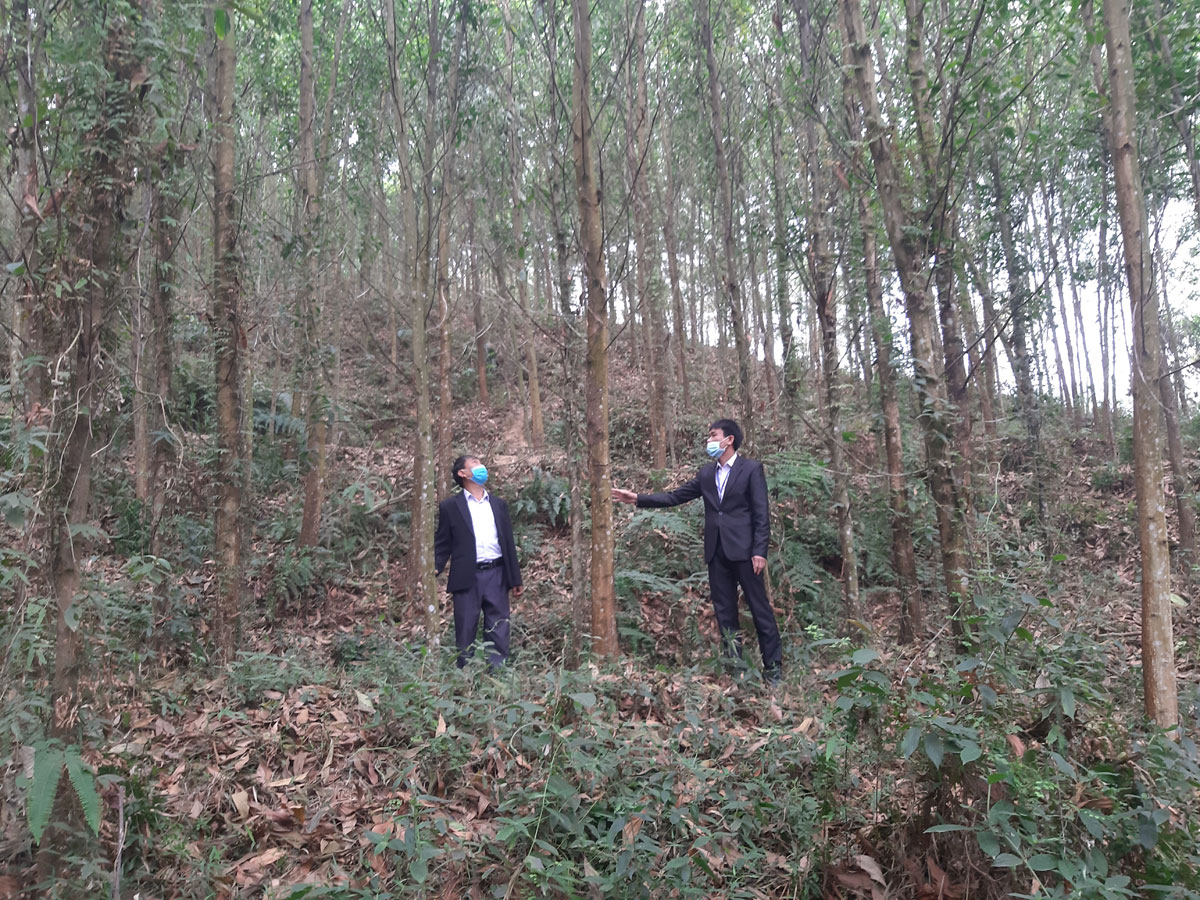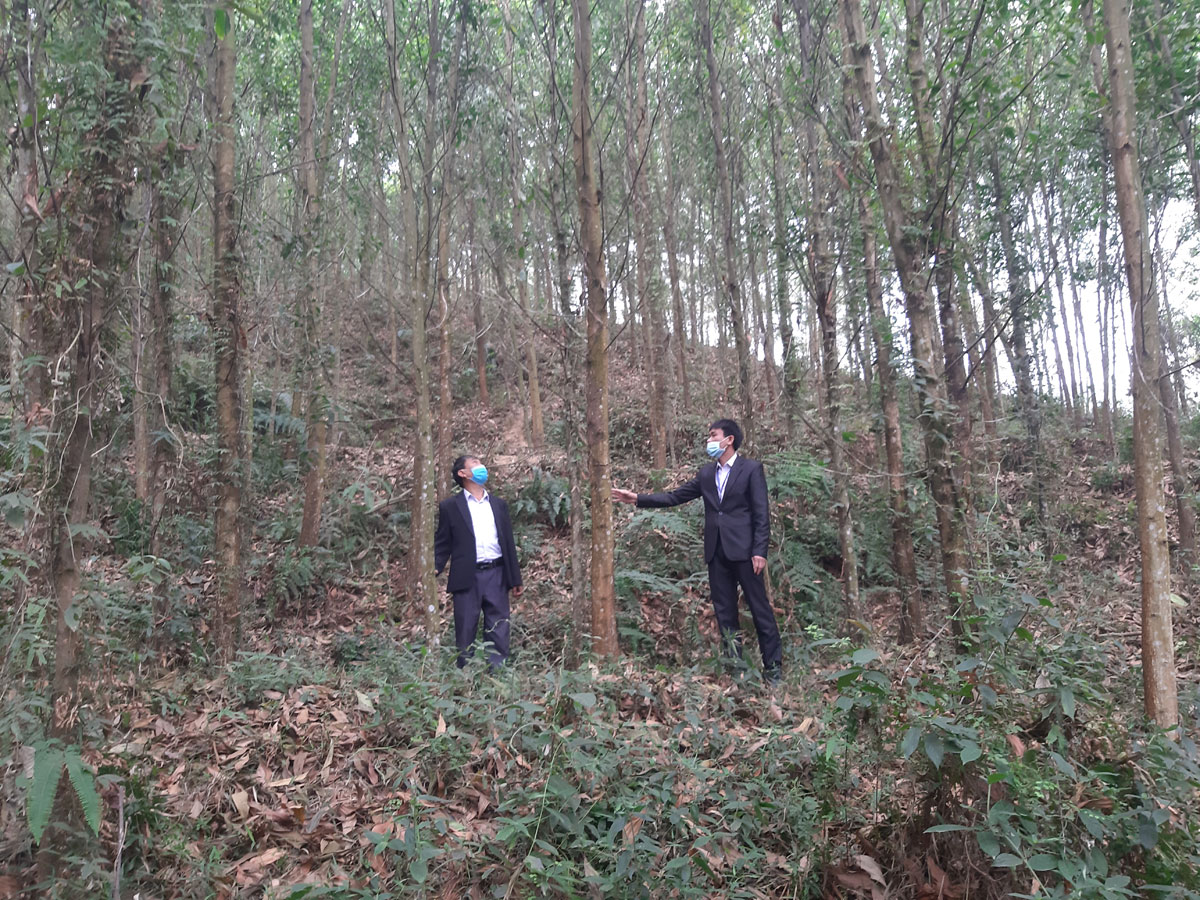
(HBO) - The Hoa Binh provincial Party Committee and People's Committee have been directing sectors and localities to build policies to support forest-based economic development towards improving productivity and efficiency, and changing forestry production practices from extensive to intensive cultivation.
The locality aims to expand the area of large timber plantation area serving
the for-export processing industry, and speed up the restructuring of the forestry
sector.
 Du Phuong village in Hoa Binh city's Mong Hoa commune has over 400
hectares of production forest whichbrings high economic value for local
residents.
Du Phuong village in Hoa Binh city's Mong Hoa commune has over 400
hectares of production forest whichbrings high economic value for local
residents.
Forest economy proves effective
According to a review of the province's planning for three types of forests in
2018, the total area of land designated for forest in Hoa Binh is 298,013 ha,
of which, 149,429 ha are earmarked for production forest, including 69,321.88
ha of planted forest and 51,976.04 ha of bare land.
Hoa Binh boasts great potential for developing the forestry economy thanks to
its strengths of geographical position and abundant labourers.
Deputy Director of the provincial Forest Protection Department Nguyen Xuan
Truong said production forestation is considered one of economic development
strategies of many localities in Hoa Binh, especially in the districts of Lac
Thuy, Kim Boi, Tan Lac, and Lac Son.
In recent years, the locality overfulfilled many targets on forestation, forest
management and protection. Every year, 6,000 - 8,000 hectares of production
forest were planted.
A system of tree nurseries has been built and improved to better meet the need
of forestry economic development towards improving quality, efficiency and
value of the forestry sector, while forest owners have been provided with
forest planting techniques through training courses.
Enterprises have paid attention to improving the value of their forest
products, and initially converting planted forests to commercialforests.
Currently, the forest coverage rate in the province stands at 51.5 percent.
In 2020, the total income from forests and forestry land of organisations and
households reached an estimated 668 billion VND (nearly 29 million USD), up 234
billion VND compared to the previous year.
The province is now home to dozens of establishments specialising in producing
and processing wood products. A number of enterprises have built medium-density
fibre board (MDF) processing and manufacturing factories, such as Vinafor MDF -
Tan An, MDF Phu Thanh, and BWG Mai Chau.
These are the foundation for the locality to build planning of material areas,
and connect planting, exploitation and processing of forest products with
consumption and development of production forest.
Supporting investment in intensive forestation
According to the agricultural sector, the productivity, quality and economic
value of planted forests in Hoa Binh remain lower than the national average
rate.
In particular, the area of forest granted
sustainableforestmanagement certificate by the Forest Stewardship
Council (FSC) accounted for only 17 percent of the total area.
The locality has faced difficulties in organizing production and investment in
intensive farming, and in drawing businesses to participate in the chain of production,
planting and processing.
To overcome the above mentioned shortcomings, the standing board of the
provincial Party Committee has issued a resolution on sustainable forest
development in Hoa Binh to 2025, with a vision to 2030.
The resolution set targets of increasing the annual forest coverage rate to
over 50 percent, the productivity of planted forest by 1.3 times, and the value
per hectare of planted forest by 2.5 times; transforming 3,000 ha of areas of
small timber plantation to large timber forests; and having 50 percent of
forest areas granted FSC certificates.
Over 90 percent of production forest area in Hoa Binh will be large timber
plantation area and commercial forests by 2030, while over 80 percent of the
area of production forest will be certified by FSC.
Forestry is expected to account for 20 percent of the proportion of
agriculture, forestry and fishery sector.
Recently, the Provincial People's Committee has issued a project on sustainable
development of production forests for the period to 2025, with a vision to
2030.
Accordingly, the locality will take measures to raise public awareness of the
importance of forestation and improve the effectiveness of forest management,
while implementing policies to support the development of intensive forestation
and large wood forests, and improving the capacity for forest farmers.
It also focuses on developing multi-function forestry, changing product
structure from exploiting young wood and producing wood chips to exploiting
large timber in order to create concentrated material areas to meet the demand
of the wood processing industry, thus improving economic efficiency of planted
forests towards contributing to the locality’s economic growth and protecting
the environment.
Truong said the provincial Party Committee and People's Committee have clearly
defined the importance of sustainable forest economic development, noting that
the resolution of the provincial Party Committee and the project on sustainable
forestry development of the provincial People's Committee are in line with the
forestry sector’s development trend, and the country’s green and sustainable
development orientation.
When a large material area with good quality is formed, it will help attract
more businesses to join a chain of industrial and natural wood products
production and processing with high added value, thus boosting exports to the
US, Japan and European markets, he said./.
By Le Chung
According to data from the Hoa Binh Provincial Party Committee, the industrial production index for the first six months of 2025 is estimated to have increased by 20% compared to the same period last year. This marks the highest year-on-year growth rate for this period since 2020.
In the first six months of 2025, Hoa Binh province’s export turnover was estimated at 1.145 billion USD, marking an 18.11% increase compared to the same period in 2024. Import turnover was estimated at $ 804 million, a 17.15% increase, which helped the province maintain a positive trade balance.
The lives of the ethnic minority farmers in Tan Lac district have gradually improved thanks to the new directions in agricultural production. This is a testament to the collective strength fostered through the professional associations and groups implemented by various levels of the district’s Farmers’ Union.
With the motto the "product quality comes first,” after nearly one year of establishment and operation, Muong village’s Clean Food Agricultural and Commercial Cooperative, located in Cau Hamlet, Hung Son Commune (Kim Boi district), has launched reputable, high-quality agricultural products to the market that are well-received by consumers. The products such as Muong village’s pork sausage, salt-cured chicken, and salt-cured pork hocks have gradually carved out a place in the market and they are on the path to obtaining the OCOP certification.
In the past, the phrase "bumper harvest, rock-bottom prices" was a familiar refrain for Vietnamese farmers engaged in fragmented, small-scale agriculture. But today, a new spirit is emerging across rural areas of Hoa Binh province - one of collaboration, organisation, and collective economic models that provide a stable foundation for production.
Maintaining growing area codes and packing facility codes in accordance with regulations is a mandatory requirement for agricultural products to be eligible for export. Recently, the Department of Agriculture and Environment of Hoa Binh province has intensified technical supervision of designated farming areas and packing facilities to safeguard the "green passport" that enables its products to access international markets.



 Du Phuong village in Hoa Binh city's Mong Hoa commune has over 400
hectares of production forest whichbrings high economic value for local
residents.
Du Phuong village in Hoa Binh city's Mong Hoa commune has over 400
hectares of production forest whichbrings high economic value for local
residents.